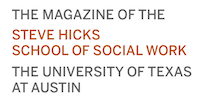 LinkedIn can help social workers discover connections to people and organizations, search for jobs, find resources for clients, extend networks of trusted contact, and engage with professionals from other disciplines.
LinkedIn can help social workers discover connections to people and organizations, search for jobs, find resources for clients, extend networks of trusted contact, and engage with professionals from other disciplines.
Jennifer Luna, director of the DiNitto Career Center, shares tips for strategically using LinkedIn to help your career and your clients.
PROFILE
Your LinkedIn profile provides a snapshot of your career, achievements, skills, and knowledge areas. It gives you a platform to enhance your visibility, manage your reputation, and give a digital elevator speech through a professional summary. One of the most valuable assets of your LinkedIn profile is the ability to document your career through keywords, posts, recommendations, and groups.
PHOTO
Your photo is the first element that other users will notice. It is worth the investment to get a professional headshot that looks like you, fills the frame with your face, and has a non-distracting background.
PROFESSIONAL HEADLINE
The professional headline appears immediately below your name, at the top of your profile. If you do not create one, LinkedIn will default to your current position and organization. As this information will already appear in the experience section, you don’t want to repeat it. Be strategic and choose a headline with keywords that describe your skills, areas of practice, geographical location, and titles. For example: LMSW/Older Adults/Loss and Grief/Austin, TX. Remember to use these same keywords throughout your profile.
PROFESSIONAL SUMMARY
The summary can be written in first or third person. Tailor it to your audience by looking at the language of the industry that you are interested in, and matching that language. Be sure to include your skills, knowledge areas, and the geographical area where you want to work. Don’t be afraid to list accomplishments such as awards or “work victories” such as programs developed. Make sure to include the transferable skills you have gained such as foreign language, communication or research skills, and leadership experience. Everyone has transferable skills, and if you aren’t sure what yours are, ask your peers and mentors what makes you different from others. You will be surprised about how often others can see skills that you may have overlooked.
JOB SEARCH
Once your profile is ready, LinkedIn can be a powerful job-search tool. You can search jobs by name, field of practice, function, or task; you can create job alerts, save and review jobs you have applied for, and automatically view jobs that are similar to the ones you have reviewed.
If you are not sure what to search, look at the language used by your connections, mentors, or people who hold positions like the ones you are seeking, and use those keywords or titles.
LinkedIn also gives you the ability to view mutual connections within the organization/s you may be interested in. Find out what they do for the organization and reach out to them for an “informational interview” before applying that can help you gain insight to tailor your materials.
CONNECT AND ENGAGE WITH GROUPS
LinkedIn groups are informal communities of like-minded individuals, formed around areas of practice, academic institutions, or themes. There are millions of groups to join, and any LinkedIn member can create one. Look at groups that your connections have joined, and the chances are that one or two will match your interests. When you join the right groups, it’s easy to keep up with trends in the field, ask and answer questions, meet new connections, and find resources for your clients.
For more career resources, visit the DiNitto Career Center


